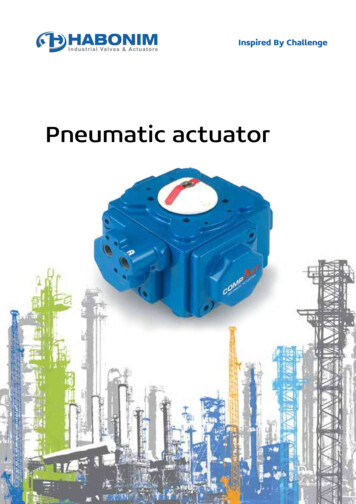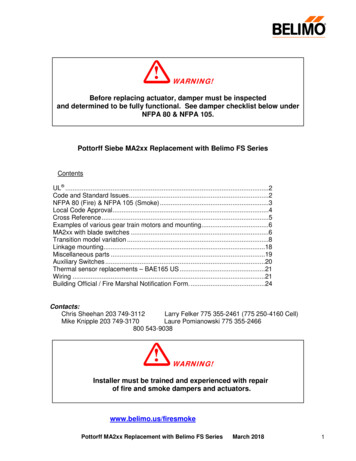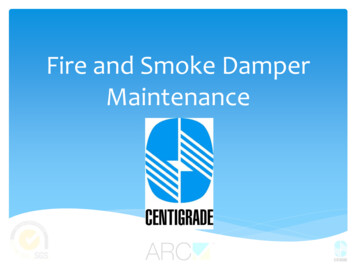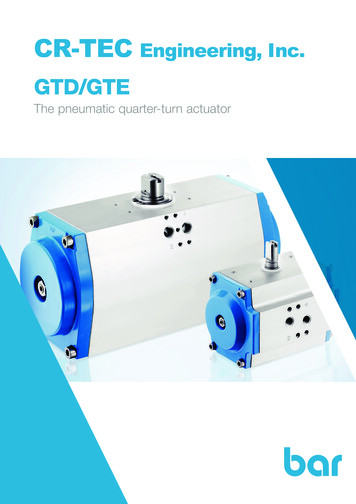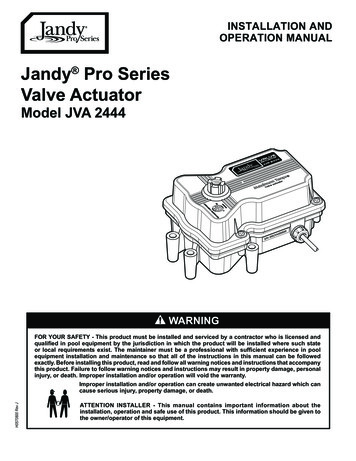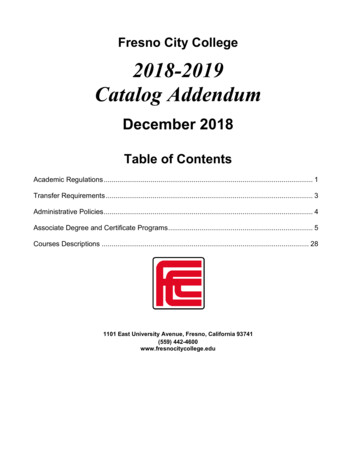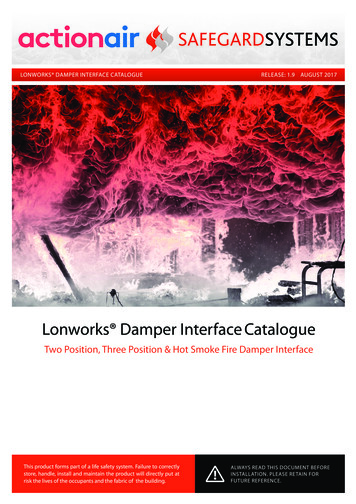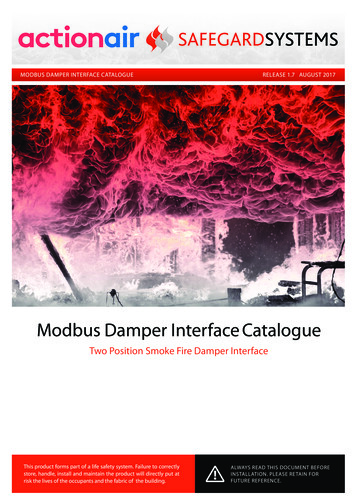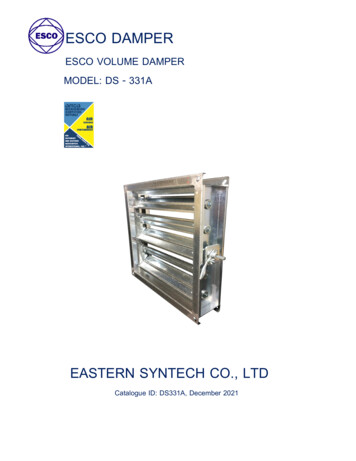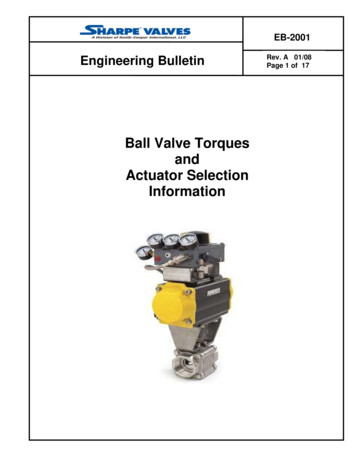
Transcription
APPLICATION GUIDEDamper Actuatorselection for HVAC systemsusa.siemens.com/openair
The right damper actuatorfor any HVAC applicationOur OpenAir series provides more torque sizes to meet all of your needs. With over 40 years of innovatingcontrol actuators, Siemens is a recognized global leader in HVAC damper actuators. Energy-efficient, robust,flexible and reliable – save time and costs with OpenAir.Table of Contents:Why the rightactuator mattersSelecting theright actuatorCommon damper typesand applications2
Why the rightactuator matters1Over-sizing Potential damage to your equipmentUnder-sizing Equipment won’t function properly Potential damage to the equipment Decreased energy efficiencyImproper control signal Overworking the equipmentThe most common issues that come up when choosing theright damper actuator are under-sizing, over-sizing andimproper usage signal. It is best to mitigate risk to ensurethat the actuator and equipment functions properly.Over-sizing risks include applying too much torque whichcan damage your equipment and costs more in the long run.There may have been an opportunity to use a slightly smalleractuator.Under-sizing is a similar situation and this typically comeswhen the actual maximum torque that is required to movethe equipment is not fully known. Sometimes tolerancesstack up, or there is chattering or binding in the damper andthe break-way torques rise higher than what the actuatorcan physically manage.An example of under-sizing a damper actuator would bewhen you determine an actuator for use on a single mixed-airdamper, when in reality the damper is linked to an additionalreturn air unit, thus increasing the overall required torque.If the damper actuator is improperly sized and unable to openthe return air and mixed air dampers to the proper positionwhile under airflow, then the equipment won’t functionproperly. This will drastically overload the equipment and usemore energy than what is required since the chiller is workingovertime to make up for the incorrect positioning of thedampers.These are a few of the reasons why selecting the rightactuator matters.3
2Selecting theright actuatorActuator Selection ChecklistBEFORE GETTING STARTED:To determine what actuator is neededfor the application use a checklist like theone in the example shown to the right.1. Assess damper physical properties 2. Check the specifications3. Understand application requirements4. Adjust for mounting or accessoriesAfter creating a checklist, follow this path:CreateChecklistCheckDamper LabelVisitManufacturer’sWebsiteMultiplyDamper Areaby TorqueFactor#1: Assess damper physical propertiesAssessing the damper’s physical properties and checking thedamper specification is critical in finding the torque needed.Understanding other application requirements and mountingneeds comes with determining a more specific part number.Most of the time, you can find out the damper's physicalproperties by simply looking at it. You can see whether thedamper is an opposed blade, or parallel blade damper; or ifthere are seals on it and so forth. However, if the damper isalready installed and you can’t see inside, then the easiestway to determine the damper’s physical properties is bylooking for the damper product label. A damper product labelDetermineTorque will have most of the information that is needed. Sometimes,the label may also include the required torque, or a specificactuator listed.Finding the label and the damper part number:If the label and the damper part number can't be found, thenvisit the specific manufacturer's website. Search the damperpart number, and link to a torque requirement table thatshows a torque factor.Information that can befound on a label:– Square Footage– Required Torque– Max Pressure Ratings– Damper Part Number– Max Air Velocity or CFM– Temp. Ratings– Seal Type or Material– Blade Length– Blade Action4
#2: Check the specificationsActuator Selection Checklist1. Assess damper physical propertiesBy knowing the ratings and specifications of the damper,you'll be able to find the torque vector needed. Siemenstorque vector table is as follows:2. Check the specifications 3. Understand application requirements4. Adjust for mounting or accessoriesTorque Vector TableTorque Factor (Lb. In/Ft²)Air Velocity (Ft/Min) 1200 2500 3000Opposed Blade No Seals34.56Opposed Blade with Seals67.510Damper Blade StyleParallel Blade No SealsParallel Blade with Seals4688.510.514EXAMPLE:In this example, the damper physical properties are 36 inches by 36 inches with opposed blade damper and seals andhas a maximum air velocity of 2,000 ft/min. The next step is to find the required torque. To do that, multiply the torque factorby the square footage of the damper.Torque RequirementsOpposed Blade Dampers withParallel Blade Dampers withNo SealsLow Leakage SealsNo SealsLow Leakage SealsMaximum Pressures of 2 in. wg orMaximum Velocities of 1500 fpm3 in-lb/ft25 in-lb/ft24 in-lb/ft27 in-lb/ft2Maximum Pressures of 3 in. wg orMaximum Velocities of 2500 fpm4.5 in-lb/ft27.5 in-lb/ft26 in-lb/ft210.5 in-lb/ft2Maximum Pressures of 4 in. wg orMaximum Velocities of 3000 fpm6 in-lb/ft210 in-lb/ft28 in-lb/ft214 in-lb/ft2Torque Formula:Required Torque (LbIn) Damper Area * Torque FactorRequired Torque (LbIn) Damper Width (In) * Damper Height (In)144(In2Ft2)* Torque Factor(LblnFt2)5
Physical Properties: Know the MeasurementsFinding these four data points are crucial to understanding what torque is required for the application,so that the right actuator is chosen.#1 Evaluate the total area of the damperL"First, find the square footage of your damper. Check ifthe damper section is longer than 96". If it is, then itmust have two total actuators on the shaft - one oneither side of the damper. This eliminates any deflectionor binding that may happen when operating a damperof that length.W"L” x W” (Total sq. inches / 144) Total sq. Ft.#2 Determine blade configurationAirflow throughopposed blade damperat one-third closedNext, determine the blade configuration or bladeaction. This is critical since the torque required tooperate these dampers differs. This is due to the airflowpassing between the damper blades while rotatingopen or closed. Depending on the configuration andthe direction of the airflow, there may be an assistanceprovided during a part of the actuator stroke.Opposed BladeParallel Blade#3 Type of damper seal – blade or edge?While looking at the blade configuration, it will be easyto determine if there are edge, blade seals or both onthe damper. This typically depends on the leakagerating of the dampers, and what the supplier hasspecified.DamperBlade SealDamperBladeDamperBlade PinEnd SealBottomSealIf seals are located on the damper, the torque valuewould increase compared to an assembly that had noseals. This is due to the seals needing to be properlyengaged at the start or end of the actuator stroke tomake sure the damper assembly meets the leakagespecification.#4 Air velocity, static pressure or designed CFM to be used in the system?The last major point is knowing the maximum airvelocity, maximum static pressure or the maximumdesigned CFM that this damper will be subjected to.Knowing this is a critical piece of information since themanufacturer’s torque tables, along with the Siemenstable, has varying torque factors based on the max airvelocity or pressure differences.6
How to find the damper torqueStep 1:Go to the manufacturer’s website and search the damperpart number. In some cases, a QR code will be located on thedamper itself. Scan the QR code with your phone's cameraand it will direct you to the specific damper's sections.Torque Vector TableTorque Factor (Lb. In/Ft²)Air Velocity (Ft/Min) 1200 2500 3000Opposed Blade No Seals34.56Opposed Blade with Seals67.510Parallel Blade No Seals4688.510.514Damper Blade StyleStep 2:Once you’re on the manufacturer’s website, find theTorque Requirement Table containing the torque factorinformation needed.Step 3:Using your check list of information and the chart provided,you find that the torque factor is 10.5 in-lb./ft squared. Now,multiply that torque factor by square feet, check all the unitsand find the torque that is needed for this application whichis just under 94.5 lb.-in.Parallel Blade with SealsEXAMPLE:To find the required torque for an outside air damper, inspect the damper. In this example, it has a manufacturer labelon it with product specifications that provides all the critical information needed on your check list.Torque RequirementsOpposed Blade Dampers withParallel Blade Dampers withNo SealsLow Leakage SealsNo SealsLow Leakage SealsMaximum Pressures of 2 in. wg orMaximum Velocities of 1500 fpm3 in-lb/ft25 in-lb/ft24 in-lb/ft27 in-lb/ft2Maximum Pressures of 3 in. wg orMaximum Velocities of 2500 fpm4.5 in-lb/ft27.5 in-lb/ft26 in-lb/ft210.5 in-lb/ft2Maximum Pressures of 4 in. wg orMaximum Velocities of 3000 fpm6 in-lb/ft210 in-lb/ft28 in-lb/ft214 in-lb/ft2Torque Formula:Damper Area (Ft2) 36 (In) * 36 (in)() 1,296 (In2)() 9 Ft2Torque Factor( 10.5(LblnRequired Torque (LbIn) Damper Area (Ft2) * Torque Factor * Torque Factor(Lbln144In2Ft2144In2Ft29 * 10.5 94.5 LbInFt2Ft2LblnFt2)))7
#3: Understand application requirementsActuator Selection Checklist1. Assess damper physical propertiesThe third step is understanding the application requirements.Choose which actuator fail position is the best fit for theproject and decide what voltage and control signalis needed.Spring Return2. Check the specifications3. Understand application requirements 4. Adjust for mounting or accessoriesvs.Non-Spring ReturnSelecting a fail positionUnderstanding the actuator's fail position (non-spring return vs. spring return) is important. If the power supply is lost, theactuator will either fail in its current position, or the mechanical spring takes over and forces the actuator back to its originalstarting position.In certain cases when power is lost and the application requires protection to the internal components, the damper should beforced to its original starting position. This would be a use case for fail-safe spring return actuators.A situation where a fail-in-place non-spring return actuator would be used is in a damper near a fan. If power is lost, make surethat damper is forced back to the fully closed position, so an actuator that has fail-safe can protect the internal components.24 VAC/DCOffOnOffOnOnDifferentialFloatingACControlled Variable230 VACOffTimeOperatingDifferential FloatingOperatingTimeModulatingControlled Variable120 VACDC2-PositionControlled VariableWhat’s the voltage and control signal?Consider the appropriate voltage needed along with choosingthe correct control signal. Choosing an incorrect controlsignal could lead to improper use of equipment which leadsto lost dollars.ProportionalIntegralSetpointTime8
#4 Adjust for mountings or accessoriesThe final two options that are available for the damperactuators are dual-auxiliary switches and specific mountingconnections.Auxiliary switches help verify the actuator positioning, sincea contact can be used to operate other low voltage devices at5% and 85% of the actuator’s rotation.Actuator Selection Checklist1. Assess damper physical properties2. Check the specifications3. Understand application requirements4. Adjust for mounting or accessories If there are any difficulties in mounting the actuator to theshaft, Siemens has a variety of mounting accessories such asfoot mounts, tandem mounts, linkage kits and even rotary tolinear kits that can be used for OpenAir actuators.For installations requiring a bit more protection from theelements, consider adding a weather shield.Putting it all togetherNow that all the steps have been covered to select the rightactuator, let's review the original example. The outside airdamper required 95-inch pounds of torque to properly open.Since it is an outside air application, a fail-safe spring returnactuator is required. 24Vac is common in this application,along with a modulating 2-10V signal, with dual auxiliaryswitches built in to ensure the fan starts and stops dependingon the actuator’s rotation. In this scenario, the damper shaftis easily accessible, and no specific accessories are needed.Taking all that information and looking through the Siemensbrochure, online HIT tool, or catalog, it is decided that aSiemens GCA156.1P actuator is the perfect fit.Outside Air Damper Example Recap: Torque Requirement 94.5 Lb.-In Fail-Safe is needed Spring Return Voltage 24Vac Control Signal Modulating 2-10V Aux. Switches Yes No specific accessories neededGCA156.1PIn the end, following these steps in this checklist will save you time,money and headaches in the future.Actuator Selection Checklist Assess damper physical properties Check the specifications Understand application requirements Adjust for mounting or accessories9
Common actuator typesand applicationsFind the right damper actuator for any HVAC application. Siemens has a range that meets all your needs. Energy-efficient,simple, flexible and reliable: your benefits are at the heart of the entire damper actuator range, from smooth installationand rapid commissioning to operation that is both efficient and convenient. Save time and costs with OpenAir.Fast-ActingBest Suited Control:On/Off, Floating or ModulatingRecommended Uses: Fume Hoods Supply & Exhaust Air TerminalsFire and SmokeBest Suited Control:On/Off or 2 PTRecommended Uses: Fire Dampers, Smoke Dampers,Combination Fire andSmoke DampersNon-Spring ReturnBest Suited Control:On/Off, Floating or ModulatingRecommended Uses: Constant or Variable Air Volume Terminal Units Bypass Dampers Makeup Air Dampers Multi-zone Mixing BoxesSpring ReturnBest Suited Control:On/Off, Floating or ModulatingRecommended Uses: Terminal Units Rooftop Units (RTU) Face and Bypass Dampers Outside Air Dampers Unit VentilatorsAdvantages: 2-Second timing Compact design High rated life-cycle performanceAdvantages: Built-in quick connect capability to electronicfusible link High temperature rating Larger torque offering Relatively low costAdvantages: Relatively low cost Compact design Low power consumption High rated life-cycle performanceAdvantages: Relatively low cost Compact design Low power consumption High rated life-cycle performance10
OpenAir Electronic Damper ActuatorsMore torque, greater energy efficiency, and long-lasting reliability gives youan ideal solution for all your HVAC equipment needs.40 Years1.5 Million60 Thousand100%25%20%Innovating controlactuatorsFactory testedOpenAir repositionoperations for longer lifeLower powerconsumptionFull strokes at rated torqueand temperatureMore torque thanthe competitionRely on Siemens for the best possible system performance.The right HVAC device matters to make your perfect place a reality.Siemens Industry, Inc.Building Products1000 Deerfield ParkwayBuffalo Grove, IL 60089-4513USATel. 847-215-1000Siemens Canada Limited Headquarters1577 North Service Road EastOakville, ON L6H 0H6CanadaTel. 905-465-8000All rights reserved. Printed in USA 2020 Siemens Industry, Inc.153-SBT-2704 (07/20)11
for any HVAC application Our OpenAir series provides more torque sizes to meet all of your needs. With over 40 years of innovating . control actuators, Siemens is a recognized global leader in HVAC damper actuators. Energy-efficient, robust, flexible and reliable - save time and costs with OpenAir.
